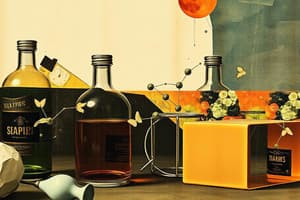Podcast
Questions and Answers
What happens when a fatty acid is reacted with NaOH?
What happens when a fatty acid is reacted with NaOH?
RC(=O)O-Na+ + H2O
Why is ethanol added to the reaction mixture of fat and base in the making of soap?
Why is ethanol added to the reaction mixture of fat and base in the making of soap?
To facilitate the mixing of fat/oil and NaOH (aq).
Why is the product of saponification a salt?
Why is the product of saponification a salt?
Because it results from the reaction of fatty acids with sodium hydroxide.
Describe the appearance of your soap.
Describe the appearance of your soap.
How would soaps made from vegetable oils differ from soaps made from animal fat?
How would soaps made from vegetable oils differ from soaps made from animal fat?
How does soap remove an oil spot?
How does soap remove an oil spot?
What are the pH levels of water, lab soap, commercial soap, and detergent?
What are the pH levels of water, lab soap, commercial soap, and detergent?
Does water, lab soap, commercial soap, and detergent foam?
Does water, lab soap, commercial soap, and detergent foam?
How do water, lab soap, commercial soap, and detergent interact with oil?
How do water, lab soap, commercial soap, and detergent interact with oil?
How did water, lab soap, commercial soap, and detergent react with CaCl2, MgCl2, and FeCl3?
How did water, lab soap, commercial soap, and detergent react with CaCl2, MgCl2, and FeCl3?
Which of the solutions were basic, and why?
Which of the solutions were basic, and why?
What is the equation for the saponification of trimyristin with KOH?
What is the equation for the saponification of trimyristin with KOH?
What is saponification?
What is saponification?
What is soap?
What is soap?
What's the product of hydrolysis?
What's the product of hydrolysis?
What are soft soaps made with?
What are soft soaps made with?
What's the non-polar carbon chain called?
What's the non-polar carbon chain called?
What's hydrophobic attracted to?
What's hydrophobic attracted to?
What's hydrophilic?
What's hydrophilic?
What happens to soap when it is added to a greasy substance?
What happens to soap when it is added to a greasy substance?
Polar heads are attracted to what?
Polar heads are attracted to what?
What are clusters of soap particles called?
What are clusters of soap particles called?
What do micelles form?
What do micelles form?
What do all greasy substances form?
What do all greasy substances form?
The carboxylate ends of soap react with what?
The carboxylate ends of soap react with what?
What are synthetic cleaning agents?
What are synthetic cleaning agents?
Why do detergents work well with hard water and in soft water?
Why do detergents work well with hard water and in soft water?
What is a typical detergent?
What is a typical detergent?
What do the LDF's do?
What do the LDF's do?
Flashcards are hidden until you start studying
Study Notes
Saponification Process
- Saponification occurs when fatty acids react with NaOH, producing sodium salt of the fatty acid and water.
- Ethanol is added to the reaction mixture to assist in emulsifying fat/oil and NaOH.
Properties of Soaps
- The appearance of soap is influenced by the type of fat or oil used during saponification.
- Soaps from vegetable oils tend to be liquid due to unsaturated fatty acids, while soaps from animal fats are solid because of saturated fatty acids.
- Saponification results in the creation of fatty acid salts, which are essentially the soap.
Mechanism of Soap Action
- Soap removes oil spots through the formation of micelles, with non-polar tails of soap embedding into oil to render it soluble in water.
- Micelles consist of non-polar oil droplets at the center, surrounded by polar heads that interact with water.
Cleansing Efficacy
- Lab soap produces some foam, while commercial soaps and detergents generate more foam.
- Detergents, unlike traditional soaps, remain effective in hard water because they do not form insoluble salts with metal ions.
Chemical Reactions and Properties
- Laboratory and commercial soaps are basic because they contain carboxylate ions that react with water to release hydroxide ions.
- Soft soaps are made using KOH, resulting in potassium salts instead of sodium salts used in traditional soaps.
Micelles and Interaction
- Soap particles cluster to form micelles, allowing for the entrapment and removal of greasy substances with water.
- The hydrophilic polar heads of soap are attracted to water, while hydrophobic tails are drawn to non-polar substances like grease.
Synthetic Detergents
- Synthetic agents known as "syndets" are detergents not derived from natural fats/oils and are formulated to function effectively in all water types.
- Typical examples include sodium lauryl sulfate, a biodegradable detergent.
Summary of Key Points
- Soap acts as an effective cleaning agent due to its unique chemical structure, forming micelles that cut through grease.
- Understanding the chemistry of soaps and detergents is crucial for their application in various environments.
Studying That Suits You
Use AI to generate personalized quizzes and flashcards to suit your learning preferences.




